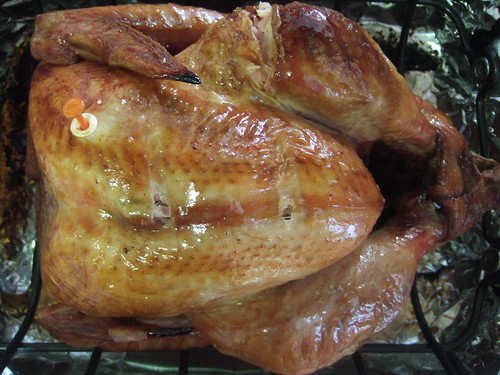Brined and Roasted Turkey
I’ll take pig any time over a turkey but this year, I thought I’d tackle most of our Thanksgiving menu because it was the first time our family was complete since my brother permanently moved out of the States. My new sister-in-law and our favorite adoptee, Cameron, joined in the festivities. With the homemade stuffing and gravy, I combed through the many turkey recipes online and decided to put two recipes together from Bill Telepan and Alton Brown. Here they are in one, tested with love.
The young twelve-pounder bird cost me almost $40 from Whole Foods so there was no room for mistake: for three days I carefully planned and participated in my first ever brined and roasted Thanksgiving turkey. I made the brine in a large glass pot where the turkey also fit; the glass pot fit in the refrigerator to brine for three days. You can definitely make your brine in a non-aluminum stockpot and just transfer it to a large container where the turkey can fit (also non-alumininum pail or basin) and just store, covered, in a cold place if it doesn’t fit in the fridge. New Yorkers who don’t have a basement can store it on their fire escape. On the day of cooking, give yourself at least five hours to prep and cook the turkey.
Ingredients:
1 12-pound young turkey, unfrozen
1 stick of butterFor the aromatics:
1 apple, sliced
1 cinnamon stick
1 bunch sage leaves
1 medium red onion, quarteredFor the brine:
1/2 cup light brown sugar
1/2 cup salt
1 tbsp black peppercorns
1 tbsp juniper berries
1 tbsp allspice berries
1 small knob of ginger, peeled, crushed, chopped1. Three days before serving, prepare the turkey in brine. Combine all brine ingredients in a large stockpot with enough water to submerge the whole turkey and bring to a boil. Stir to dissolve solids. Remove from heat and cool to room temperature. Set aside.
2. In the meantime, wash the turkey inside and out with cold water and let sit in a colander to drain.
3. Transfer the brine into a large non-aluminum container and submerge the turkey in the brine. If the turkey is not submerged fully, just make sure that you turn the turkey over 24 hours later to marinade the other side.
4. Early on the day of cooking, remove turkey from the brine into a colander to drain in room temperature for at least 30 minutes. Heat the oven to 500º while you wait with the rack on the lowest slot.
5. Prepare the aromatics. Combine the ingredients with 1/4 cup of water in a microwave-safe bowl and microwave on high for 5 minutes. Set aside.
6. Move the turkey to a chopping block and pat the turkey dry with paper towels, inside and out. Tuck back wings and drumsticks. Using your hands, rub butter and a palm-full of salt all over and inside the turkey. Add the microwaved aromatics inside the turkey. Transfer the turkey on a rack in an aluminum foil-lined roasting pan.
7. Set your alarm for these steps so you don’t forget: Roast turkey for 30 minutes. Remove from oven and cover the turkey with thick aluminum foil and continue to roast for 1 hour, lowering the temperature to 350º. Remove from oven and carefully turn over the turkey to cook the other side. (I used the aluminum foil as potholders to turn it by hand.) Cover again and cook for another hour. Remove from oven a third time, uncover, and return to the oven for another 30 minutes to brown that side.
8. A total of three hours cooking time later, remove the turkey from the oven, stick a meat thermometer in the thigh and make sure the thickest part of the bird is perfectly cooked. (My thermometer said turkey is 180º.) Set the turkey, still on the rack, on a chopping block and let rest for up to 30 minutes before carving and serving.
Related post/s:
I’ve been using this roasting pan with a rack. Buy it from Amazon.com.
More Thanksgiving turkey photos on Flickr
Use the leftovers for turkey portobello sandwiches
